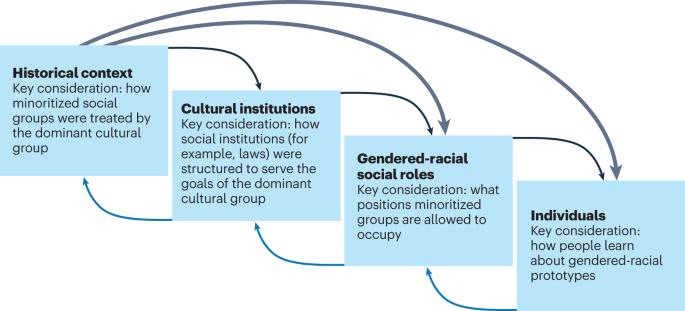A sociohistorical model of intersectional social category prototypes
IF 16.8
Q1 PSYCHOLOGY, MULTIDISCIPLINARY
引用次数: 2
Abstract
Every person belongs to multiple social categories, such as those based on gender, race, or ethnicity, yet researchers have traditionally studied beliefs about each of these groups in isolation. Theoretical perspectives have emerged that aim to outline how people’s mental representations of gender and race or ethnicity are systematically intertwined. These intersectional perspectives have been generative, but there remain areas of ostensible disagreement that create conceptual confusion. In this Perspective, we suggest that a sociohistorical approach can help to reconcile these differences by highlighting how previous theories offer complementary, rather than conflicting, insights into the structure of social concepts. Specifically, we propose that a sociohistorical model integrating research across social science fields (history, anthropology, sociology and psychology) could illuminate how people construct mental representations that align with their surrounding social and cultural systems, which reflect the goals of the dominant gender and ethnic or racial group. By encoding these cultural ideals in mental representations of what members of social categories are like, people’s prototypes reinforce social hierarchies. People belong to multiple social categories (such as those based on race, ethnicity, or gender) simultaneously. In this Perspective, Lei et al. propose a sociohistorical model of intersectional social prototypes that reconciles existing theories and generates testable hypotheses about the development and structure of social prototypes.

交叉社会范畴原型的社会历史模型
每个人都属于多个社会类别,例如基于性别、种族或民族的类别,但研究人员传统上一直孤立地研究有关这些群体的信念。现在出现了一些理论观点,旨在概述人们对性别、种族或民族的心理表征是如何系统性地交织在一起的。这些交叉视角很有启发性,但仍存在表面上的分歧,造成了概念上的混乱。在本《视角》中,我们建议采用社会历史的方法,通过强调以往的理论如何对社会概念的结构提供互补而非冲突的见解,来帮助调和这些分歧。具体地说,我们建议将社会科学领域(历史学、人类学、社会学和心理学)的研究整合起来的社会历史模型可以阐明人们是如何构建与周围社会和文化体系相一致的心理表征的,这些社会和文化体系反映了占主导地位的性别、民族或种族群体的目标。通过将这些文化理想编码为社会类别成员的心理表征,人们的原型强化了社会等级制度。人们同时属于多个社会类别(如基于种族、民族或性别的社会类别)。在本《视角》中,Lei 等人提出了一个交叉社会原型的社会历史模型,该模型调和了现有理论,并对社会原型的发展和结构提出了可检验的假设。
本文章由计算机程序翻译,如有差异,请以英文原文为准。
求助全文
约1分钟内获得全文
求助全文

 求助内容:
求助内容: 应助结果提醒方式:
应助结果提醒方式:


